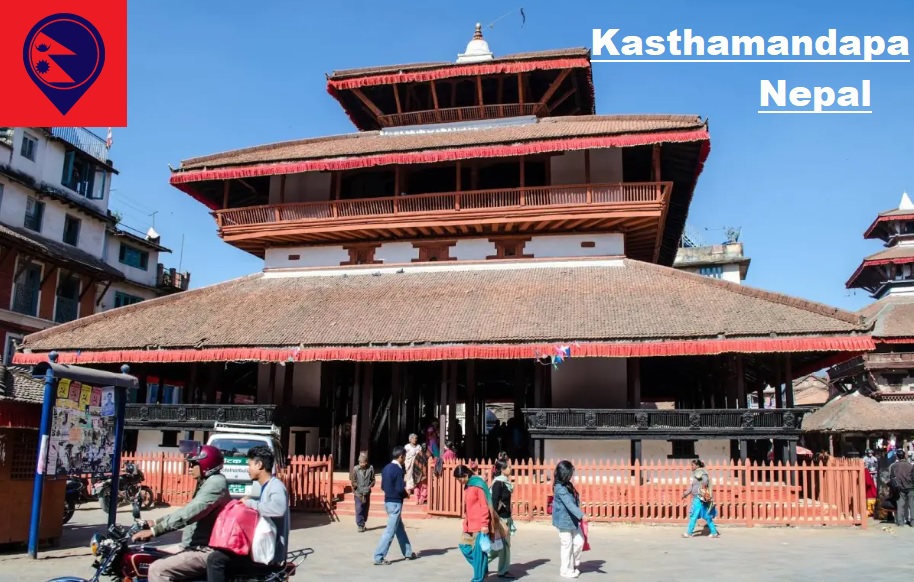Nestled in the heart of Kathmandu, Nepal, Kasthamandapa stands as a testament to ancient architectural prowess and cultural heritage. This historic pavilion, whose name translates to “Wooden Pavilion,” is one of the city’s oldest and most significant landmarks. In this blog, we will delve into the rich history, unique architecture, and cultural significance of Kasthamandapa.

Historical Significance
Kasthamandapa is believed to have been constructed in the 12th century during the reign of Laxmi Narsingh Malla. According to legend, the entire structure was built using wood from a single sal tree. This feat of engineering and craftsmanship highlights the advanced techniques and skills of the artisans of that era. The pavilion was originally a community shelter and a place for travelers to rest, eventually becoming a revered site for worship.
Architectural Marvel
The architecture of Kasthamandapa is a blend of traditional Nepalese pagoda style and intricate woodwork. The pavilion is a three-storied structure with a large, open hall on the ground floor. The intricate carvings on the wooden pillars, beams, and struts depict various deities, mythological scenes, and traditional motifs, showcasing the artistic excellence of the period.
The roof, adorned with ornate woodwork, extends outwards, providing shade and shelter. The central sanctum houses a statue of Gorakhnath, a revered yogi and a significant figure in Nepalese culture. The simplicity of the pavilion’s design, coupled with the complexity of its carvings, makes Kasthamandapa a unique architectural masterpiece.
Cultural Significance of Kasthamandapa
Kasthamandapa is not just an architectural wonder; it holds immense cultural and spiritual significance for the people of Kathmandu. It is considered a symbol of the city’s heritage and a focal point of local traditions and festivals. The pavilion is closely associated with the annual Machhindranath Jatra, one of the most important festivals in Kathmandu, where chariots of deities are paraded through the streets.
The presence of the statue of Gorakhnath further enhances the pavilion’s spiritual importance. Devotees visit Kasthamandapa to pay their respects and seek blessings, particularly during significant Hindu festivals.
The Earthquake and Restoration
In 2015, a devastating earthquake struck Nepal, causing severe damage to Kasthamandapa. The once-majestic structure was reduced to rubble, and the loss was deeply felt by the local community and heritage conservationists worldwide. However, the spirit of resilience and dedication to preserving cultural heritage led to a massive restoration effort.
The restoration project, supported by local and international organizations, aimed to rebuild Kasthamandapa using traditional materials and techniques. The goal was to restore the pavilion to its former glory while maintaining its historical authenticity. The ongoing restoration efforts symbolize the community’s commitment to preserving its cultural legacy for future generations.
Visiting Kasthamandapa
For those planning to visit Kathmandu, a trip to Kasthamandapa is a must. The pavilion is located in the bustling Kathmandu Durbar Square, a UNESCO World Heritage Site, surrounded by other historic buildings, temples, and palaces. The square is a vibrant hub of activity, offering visitors a glimpse into the rich cultural tapestry of Kathmandu.
Tips for Visitors of Kasthamandapa
- Respect the Site: Kasthamandapa is a revered cultural and spiritual site. Visitors should dress modestly and behave respectfully.
- Photography: While photography is generally allowed, it is advisable to check for any restrictions, particularly during religious ceremonies.
- Local Guides: Hiring a local guide can enhance your visit by providing in-depth knowledge about the history and significance of Kasthamandapa and other landmarks in Kathmandu Durbar Square.
- Timing: The best time to visit is during the early morning or late afternoon when the square is less crowded, allowing for a more peaceful experience.
Kasthamandapa is more than just an ancient pavilion; it is a symbol of Kathmandu’s rich history, architectural ingenuity, and cultural resilience. Visiting this historic site offers a unique opportunity to connect with Nepal’s heritage and appreciate the enduring legacy of its craftsmen and builders. As the restoration of Kasthamandapa continues, it stands as a beacon of hope and a reminder of the importance of preserving our cultural treasures.
For Further Information
Nepal Tour Package provides the best tour packages for the travel lovers of each type, whether it is Adventure Tour, Spiritual Tour, Beach Tour, Family Tour, Heritage Tour, Holiday Tour & Wildlife Tour.
For more information call our tour experts: +91 –7982194316
Get the best Holiday Offers
Email Us at :- info@nepaltpurpackages.com




